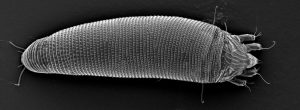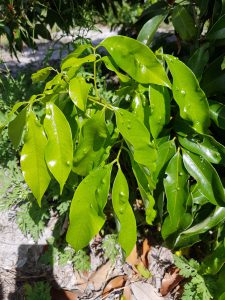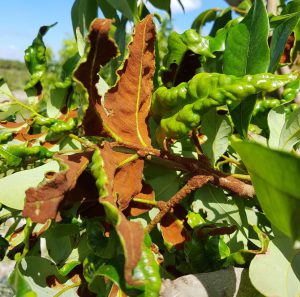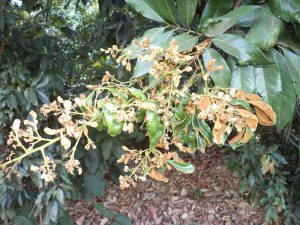Daniel Carrillo1, Alexandra M. Revynthi1, Jeff Wasielewski2, Christian Miller3 and Jonathan H. Crane4
The Lychee Erinose Mite (LEM), Aceria litchii (Figure 1), was found in a 3-acre commercial lychee orchard in Lee County on Pine Island, FL in February 2018.

Infestations were recorded on young leaves, stems, and inflorescences of the lychee varieties, ‘Mauritius’, ‘Hak Ip’, and ‘Sweet Heart’.

LEM is native to Asia where it is a severe pest to lychee (Litchi chinensis). The mite has also been reported in Hawaii, Australia, and most recently Brazil.
Although LEM is present in Hawaii, the mite is a prioritized quarantine pest in the continental U.S. and other territories. The February 2018 find is the third introduction of LEM in Florida. The first detection was in 1955 in a lychee grove located at Nokomis in Sarasota County and the second was an interception recorded on plants, imported from China, in Coral Gables, Miami-Dade County in 1993. Nevertheless, both times the pest failed to establish or was eradicated.
Florida is the leading producer of lychee and longan in the United States, followed by Hawaii and California. The estimated production area of lychee and longan is 1,230 and 1,600 acres, respectively. Approximately 90% of Florida’s commercial production is concentrated in Miami-Dade County. Small plantings and dooryard trees can be found in Polk, Highlands, Brevard, Indian River, Palm Beach, Broward, Collier, Lee, Charlotte, Sarasota, Pinellas, and Martin Counties. Notably, Lee County, where LEM was recently detected, houses several nurseries that produce lychee propagative material that is shipped to the main production area in Miami-Dade.

LEM feeds on leaf epidermal cells, causing morphological alterations, which result in the enlargement of leaf trichomes, referred to as “erinea”. Initially, LEM infests immature leaves and forms small blisters (Figure 2) with silver-white color hairs. These erinea later become a reddish-brown hairy mass that, in some instances, can cover the entire underside of the leaf, which may become distorted or curled (Figure 3). Erinea can turn almost black as infested leaves mature. Erinea may also develop on other plant parts as the LEM population grows, the mites migrate to other new shoots and feed upon petioles, stems, panicles, flower buds, and fruit (Figures 4 and 5).


LEM are extremely small and cannot be seen with the naked eye or even a regular dissecting scope (Figure 1). The eggs of LEM are laid in the erinea. This pest’s lifecycle is approximately 14 days. Multiple, overlapping generations can occur over the course of one year. Population growth is favored by new growth on trees during moderately hot and dry periods with low humidity.
This pest can be transferred by air currents or honey bees. Moreover, LEM can be disseminated by the movement of infested plants, especially when plants are propagated as air layers from infested parent trees. The mite can also be disseminated by humans touching the symptomatic leaves.
Scouting for this pest
Growers should scout their groves for this pest, looking for the distorted leaf blisters and/or the reddish-brown hairy mass formed on the underside of leaves. Please report any finding to the UF/IFAS Commercial Tropical Fruit Extension Agent (Jeff Wasielewski, sflhort@ufl.edu, 305-248-3311, ext. 227).
Please do not move these mites by moving infested plant material to any new location or by touching the symptomatic leaves.
Resources
1 Entomology and Nematology Department, UF/IFAS Tropical Research and Education Center, Homestead, FL 33031 2 UF/IFAS Extension Miami-Dade County, Homestead, FL 33031 3 UF/IFAS Palm Beach County, West Palm Beach, FL 33415 4 Horticultural Sciences Department, UF/IFAS Tropical Research and Education Center, Homestead, FL 33031
 1
1

Comments:
December 2, 2021
Thanks for this article. I'm in the starting phases of growing hemp here in swfl. I appreciate the insights! Kendra Solow @mindbodyphysique
November 6, 2021
This is great information for navigation through the details. The less confusion about the subject means more people finding a wonderful wellness product
November 5, 2021
looking to partner with any one to cultivate hemp. i had been doing row crops in homestead florida since 1989. i have my license, land and equipment. thanks. ganesh shivbaran. 3054840787
November 5, 2021
An excellent explanation of marijuana, hemp and what to beware of in the myriad CBD products now available everywhere. Good advice to read labels, select carefully and be suspicious of unregulated product claims - similar to all the food products which claim to be “organic “ and “non GMO.” Keep up the good work to educate John Q. Public!
November 5, 2021
Thank you for continuing to educate us in your field of expertise
November 5, 2021
Thank you Lisa, your commentary is very much appreciated.
November 5, 2021
Thank you for your work. ❤️ This is very well written and easy for anyone to understand.
July 27, 2021
Kenneth, I am copying Dr. Alan Chambers, the lead scientist on this research. He can help your comment/question. Alan, his comment was on the TREC blogs. Please reply. Kenneth is copied. This is interesting news. Is there any way of contacting Mr, Chambers directly. I am from Barbados in the Caribbean and am looking for a niche market product to grow on island. Thanks, bradbuck[at]ufl[dot]edu
July 23, 2021
Hi Alicia. Before you cut down your tree, you should notify FDACS-Division of Plant Industry (DPI) at 1-888-397-1517 and Jeff Wasielewski, Commercial Tropical Fruit Crops Agent, UF-IFAS Extension Miami-Dade County at 305-679-0227.
July 5, 2021
Based on the information and photos, my smaller lychee tree definitely has LEM. I’m a private homeowner, not a commercial grower. Should I contact the county and report this? The infestation is extensive and on 2/3 of the branches. Unfortunately, it seems my only recourse is to cut it down so it does not spread to my other tree.
June 28, 2021
I have read articles on new varieties of Vanilla plants being worked on by scientist Alan Chambers. This is interesting news. Is there any way of contacting Mr, Chambers directly. I am from Barbados in the Caribbean and am looking for a niche market product to grow on island.
May 14, 2021
Hi Al. Dr. Carrillo has requested you bring a sample to the Florida Extension Plant Diagnostic Clinic for further analysis. The Clinic is located at our campus, 18905 SW 280 Street, Homestead, Florida 33031. You can review the Clinic's website here: https://trec.ifas.ufl.edu/plantdiagnosticclinic/.
May 3, 2021
I have very tiny black insects, less than a cm long living on my litchee tree. They’re so tiny that’s it’s difficult to see them individually with the naked eye. They live in patches on the trunk. The patches, for lack of better description, look like black under arm hair. When disturbed they do not fly but continues to regroup like a herd. Are they harmful to my tree?
March 29, 2021
Hi Chan. Thank you for your inquiry. Dr. Carrillo has requested you visit this website for the most up to date information: https://trec.ifas.ufl.edu/Lychee-Erinose-Mite/. Thank you.
March 22, 2021
Thank you for your interest! The only document that we have available at this time is Matthew Quenaudon's master's thesis. You can find it here: https://ufdc.ufl.edu/UFE0054534/00001.
March 14, 2021
I have only just seen this on my lychee trees and the leaves are dying. It's spreading to other branches. My tree has only just started flowering. How do I get rid of this to avoid it taking over my entire tree? I have a younger one that's flowering for the first time and want to protect these so badly. Waited more than 10 years for the older one to flower. Help
February 23, 2021
Has this work been published? If so could you please provide a citation. Thank you
September 24, 2018
It is recommended that all infested branches are cut and burn before any acaricide treatment. Pruning is the most important cultural practice against the LEM and the most efficient way to remove infestations. After pruning, removing and destroying infested branches, acaricides can be used to protect new leaf flushes as they emerge and develop. Sprays applied directly to infested leaves and branches provide poor control because of the protection provided to the mites by the erineum. Among the acaricides registered for use in lychee in Florida, the only conventional pesticide registered acaracide proven to work against LEM in other parts of the world is Agri-Mek (abamectin). Agri-Mek is a restricted use pesticide (you must have a pesticide license to use this material) and has a restriction of a maximum two applications per year on lychee. Of the other insecticides known to have activity against LEM, azadirachtin, which is extracted from neem oil provides suboptimal control of this mite. Azadirachtin is labeled for use on lychee and can be used as an alternative acaricide while additional insecticides are being explored. Azadirachtin brand names include Aza-Direct, AzaGuard, Azatrol EC, and Trilogy. Although wettable sulfur has also proven efficacious against this mite, it is not registered for use on lychee at this time. Detailed control recommendations are available at: https://trec.ifas.ufl.edu/Lychee-Erinose-Mite/.
September 7, 2018
What can be sprayed on the tree to kill the invader ??
Comments are closed.